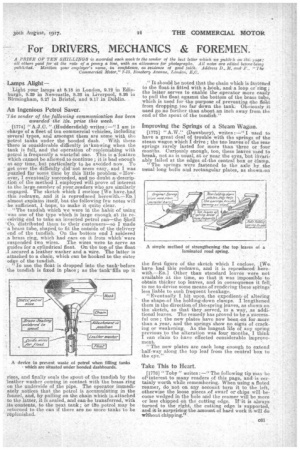For DRIVERS, MECHANICS & FOREMEN, A PRIZE OP TEN SBILLING8
Page 21

If you've noticed an error in this article please click here to report it so we can fix it.
is awarded each weekto the sender of the best fetter which we publarn on,thi; e; all others paid for at the rate of a penny a tine, with an allowance for photographs. All notes are edited betorol being publizhed. Mention your employer's name, in confidence, as evidence of gobd faith. Address D,, f, and' F., The Commercial Motor," 7-15, Roseber? Avenue, London, E.G.
Lamps Alight
•
Light your lamps at 8.18 in London, 9.12 in Edinburgh, 8.29 in Neweastle, 8.32 in Liverpool, 8.26 hr Birmingham, 8.27 in Bristol, and 9.17 in
An Ingenious Petrol Saver.
The sewier of the fallowing coganunieation has been awarded • the los. prize this week.
[1774] " "•(1Juddersfield) writes :—" I am in charge of a fleet of ten commercial vehicles, including several types, and amongst them are some with the 'Petrol tanks under the hooded dash. With these there is considerable difficulty inekno wing when the tank is full, and the operation of replenishing with petrol is frequently a wasteful one. This is a' feature which cannot be allowed to Continue ; it is bad eneaigh at any time, but particularly to be avoided now.. To get over the cliffieulty-didnot seem easy,. and I was puzzled for some time by this little problem. c However, I eventually succeeded, and no doubt .aedescripIion of the method I employed will,prove of interest . to the large numberof y.our‘readers who are similarly. engaged. The sketch which I enclose [We have. had . this redrawn, and it is reproduced herewith.-LEn.1 . almost explains itself, but the following few notes will be sufficient, I hope, to make it quite clear. , The tundish which we were in the habit of using was one of the type which is large enough at its-receiving end to take an inverted petrol can—the *hell 'Co. 'distributed them to their customers—so I made -a brass tube, shaped, to fit the outside of the delivery end of the tundish. On the bottom end I soldered .a brass ring, Which. had ears on it from which' were .suspended two wires. The wires were to serve as guides for a cylindrical float. On the top of the float .secured a leather washer and a wire. The latter is attached to a chain, which can be hooked to the ohter edge of the tundish. • " In use the float-is dropped into the -tatilv before the tundish is fixed in place ; as the tank'fills up it
rises, and finally seals the spout of the tundish by the leather • washer coming in contact with the brass ring on the underside of the pipe. The operator immediately notices that the petrol is accumulating in the funnel, and, by pulling on the chain which is.attached
• to the latter, it is sealed, and can be transferred, with. its contents, to the next tank ; Or tite petrol may be . returned to the can if there are no more tanks to be • -..rdplenished. • ." It should be noted that the chain which is fastened to the float-is fitted with a hook, and a loop or-ring ; the latter .serves to enable the operator more easily to pull the float against the bottom of the brass tube, which is used for the purpose of preventing !the Vat from dropping. too far down the tank. Obviously it need go no further than about an inch away from the end of the spout of the tundish."
Improving the Springs of a Steam Wagon.
• [17751 " A. W." Dewsbury), writes :—" I used to have a great deal of trouble with the springs of the steam wagon. which I drive ; the ten leaves of the rear springs rarely lasted for more than three or four months. Curiously enough, too, these leaves used to break, not as is usual, at or near the eyes,'but invariably failed at the edges of,the central box or Clamp. The springs were fastened to the axle by the usual long bolts and rectangular plates, as shown.on the first figure of the sketch which I enclose. • [We. have had this redrawn, and it is reproduced herewith.—En.] Other than standard leaves were not available at the time, so that it was impossible to obtain thicker top leaves, and in consequence it fell, to me to devise some meansof rendering these spiings less liable. to such frequent breakage. " Eventually I hit noon, the expedient of altering the shape.-of the holding-down clamps. I lengthened them in the direction of Ihmspring leaves, as shown on the sketch, so that they .served, in a way, as additional leaves. The remedy has proved to be a successful one ; the new plates have now been -op for -more than a year, and the springs show no signs of cracking or weakening. As the longest life of any spring previous to the alteration was four months, I think i I can claim to have effected considerable mprovement.
"The new plates are each long enough to extend half-way along the top leaf from the central box to the eye.
Take This to Heart. • [1776] " Toby" writes :—" The following tip may be oflinterest to many readers of this page, and is certainly worth while remembering. When using a fluted reamer., do not on any account turn it to the left, otherwise the loose pieces of swarf or chips will become wedged in the hole and the reamer will be more or less chipped on the cutting edge. Wit is always turned to the right, the cutting edge is supported, and it is surprising the amount of hard work it will do without chipping."






















